1993 PONTIAC BONNEVILLE check engine light
[x] Cancel search: check engine lightPage 110 of 322
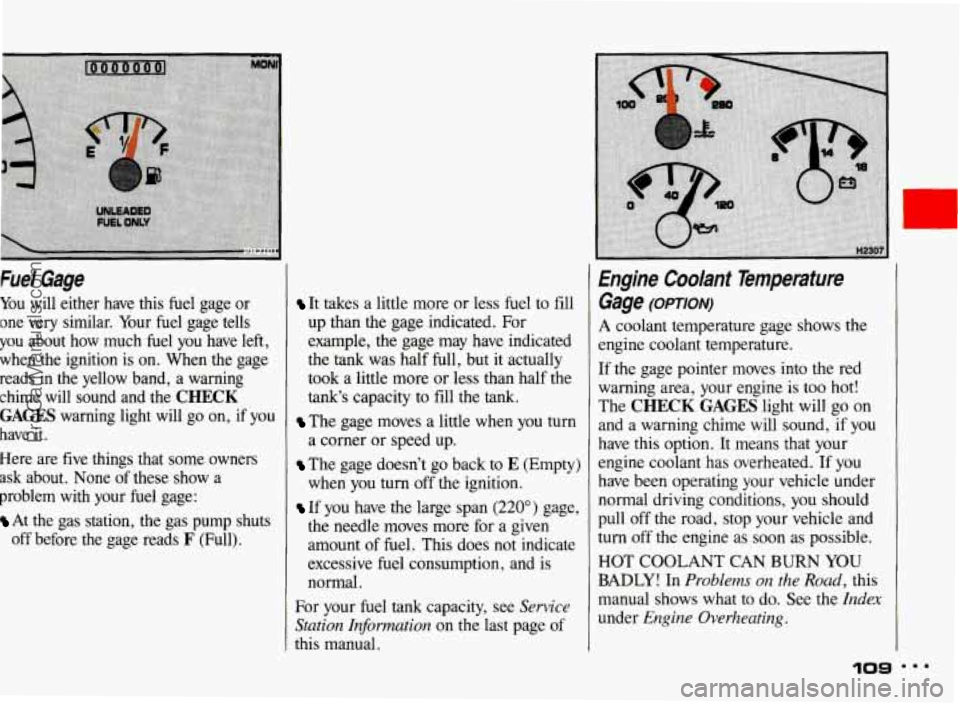
Fuel Gage
You will either have this fuel gage or
one very similar. Your fuel gage tells
you about how much fuel you have left,
when
the ignition is on. When the gage
reads in the yellow band, a warning
chime will sound and the
CHECK
GAGES warning light will go on, if you
have it.
Here are five things that some owners
ask about. None of these show a
problem with your fuel gage:
At the gas station, the gas pump shuts
off before the gage reads
F (Full).
It takes a little more or less fuel to fill
up than the gage indicated. For
example, the gage may have indicated
the
tank was half full, but it actually
took a little more or less than half the
tank's capacity to fill the tank.
The gage moves a little when you turn
a corner or speed up.
The gage doesn't go back to E (Empty)
when you turn off the ignition.
If you have the large span (220") gage,
the needle moves more for a given
amount
of fuel. This does not indicate
excessive fuel consumption, and is
normal.
For your fuel
tank capacity, see Sewice
Station Informution
on the last page of
this manual.
Engine Coolant Temperature
Gage
(OPTION)
A coolant temperature gage shows the
engine coolant temperature.
If the gage pointer moves into the red
warning area, your engine is too hot!
The
CHECK GAGES light will go on
and a warning chime will sound, if you
have this option. It means that your
engine coolant has overheated. If you
have been operating your vehicle under
normal driving conditions, you should
pull off the road, stop your vehicle and
turn off
the engine as soon as possible.
HOT COOLANT CAN
BURN YOU
BADLY! In Problems on the Road, this
manual shows what to do. See the
Index
under Engine Overheating.
10s
ProCarManuals.com
Page 111 of 322
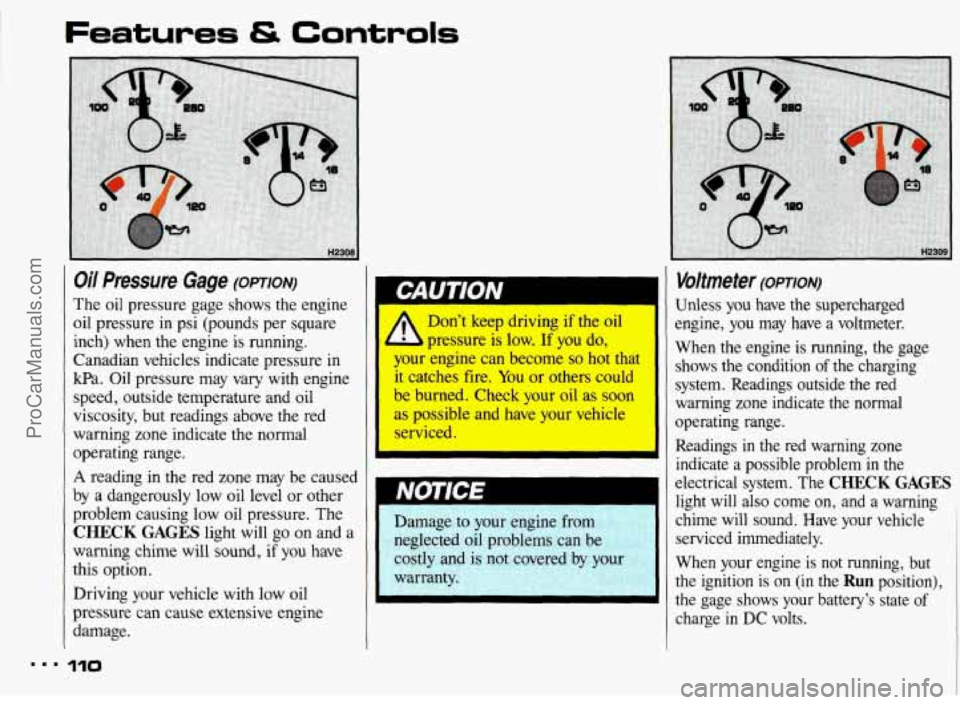
Oil Pressure Gage (OPTION)
The oil pressure gage shows the engine
oil pressure in psi (pounds per square
inch) when the engine is running.
Canadian vehicles indicate pressure
in
kPa. Oil pressure may vary with engine
speed, outside temperature and oil
viscosity, but readings above the red
warning zone indicate the normal
operating range.
A reading in the red zone may be caused
by
a dangerously low oil level or other
problem causing low oil pressure. The
CHECK GAGES light will go on and a
warning chime will sound, if you have
this option.
Driving your vehicle with low oil
pressure can cause extensive engine
damage.
I.. I10
1
Don’t keep driving if the oil
pressure
is low. If you do,
your engine can become so hot that
it catches fire. You or others could
be burned. Check your oil as soon
as possible and have your vehicle
rviced.
I
I
Damage to your engine from
neglected oil problems can be
costly and is
not covered by your
warranty.
Voltmeter (OPTION)
Unless you have the supercharged
engine, you may have a voltmeter.
When the engine is running, the gage shows the condition
of the charging
system. Readings outside the red
warning zone indicate the normal
operating range.
Readings
in the red warning zone
indicate a possible problem in the
electrical system. The
CHECK GAGES
light will also come on, and a warning ,
chime will sound. Have your vehicle
serviced immediately.
When your engine is not running, but
the ignition is on (in the
Run position),
the gage shows your battery’s state
of
charge in DC volts.
ProCarManuals.com
Page 112 of 322
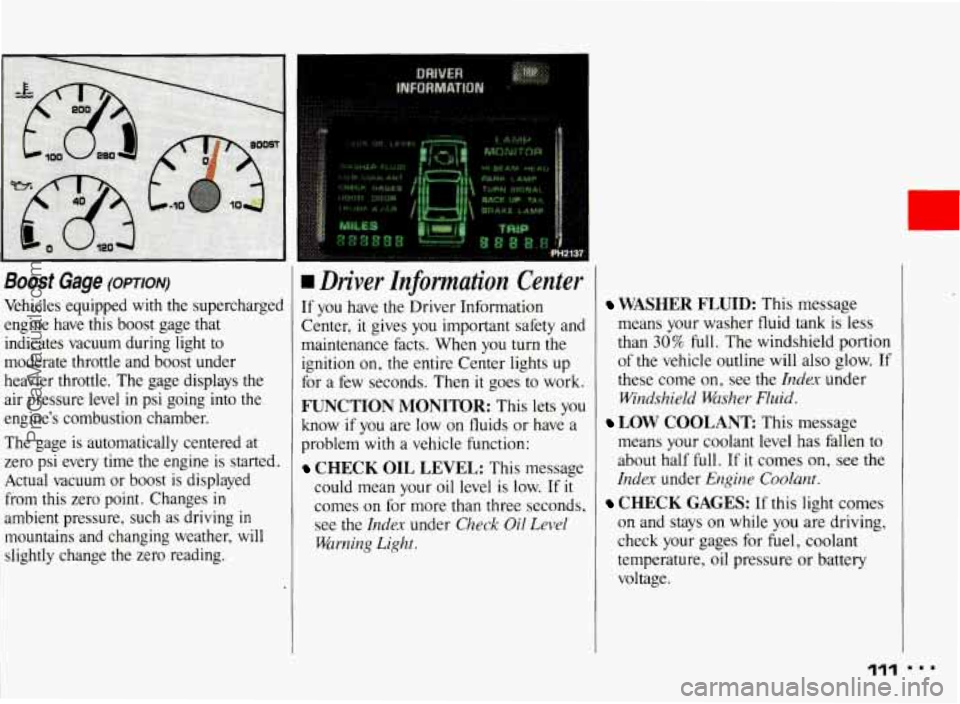
Boost Gage (OPTION)
Vehicles equipped with the supercharged
engine have this boost gage that indicates vacuum during light to
moderate throttle and boost under
heavier throttle. The gage displays the
air pressure level
in psi going into the
engine’s combustion chamber.
The gage is automatically centered at
zero psi
every time the engine is started.
Actual vacuum or boost
is displayed
from this zero point. Changes
in
ambient pressure, such as driving in
mountains and changing weather, will slightly change
the zero reading.
I
rn Driver Znformation Center
If you have the Driver Information
Center, it gives you important safety and
maintenance facts. When you turn the ignition on, the entire Center lights up
for a few seconds. Then it goes to work.
FUNCTION MONITOR: This lets you
know if you are low
on fluids or have a
problem with a vehicle function:
CHECK OIL LEVEL: This message
could mean your oil level is low. If
it
comes on for more than three seconds, see
the Index under Check Oil Level
Warning Light.
WASHER FLUID: This message
means your washer fluid tank is less
than
30% full. The windshield portion
of the vehicle outline will also glow. If
these come on, see the
Index under
Windshield Washer Fluid.
means your coolant level has fallen to
about half full. If it comes on,
see the
Index under Engine Coolant.
CHECK GAGES: If this light comes
on and stays on while
you are driving,
check your gages for fuel, coolant
temperature, oil pressure or battery
voltage.
LOW COOLANT This message
111
ProCarManuals.com
Page 175 of 322

Your Driving and the Road
Driving a Long Distance
Although most long trips today are
made on freeways, there are still many
made on regular highways.
Long-distance driving on freeways and
regular highways
is the same in some
ways. The trip has to be planned and the
vehicle prepared, you drive
at higher-
than-city speeds, and there are longer
turns behind the wheel. You’ll enjoy
your trip more if
you and your vehicle
are in good shape. Here are some tips
for a successful long trip.
174
Before Leaving on a Long Trip
Make sure you’re ready. Try to be well Here are some things you can check
rested. If you must start when you’re not
fresh-such as after a day’s work-don’t
plan to make too many miles that first
part of the journey. Wear comfortable
clothing and shoes you can easily drive
in.
Is your vehicle ready for a long trip? If
you keep it serviced and maintained, it’s
ready to go. If it needs service, have it
done before starting out.
Of course,
you’ll find experienced and able service
experts in Pontiac dealerships all across
North America. They’ll be ready and
willing to help if you need it. before
a trip:
Windshield Washer Fluid: Is the
reservoir full? Are all windows clean
inside and outside?
shape?
Have you checked all levels?
lenses clean?
safe, trouble-free trip.
Is the tread
good enough for long-distance
driving? Are the tires all inflated to
the recommended pressure?
weather outlook along your route?
Should you delay your trip a short
time to avoid a major storm system?
Maps: Do you have up-to-date maps?
Wiper Blades: Are they in good
Fuel, Engine Oil, Other Fluids:
Lights: Are they all working? Are the
Tires: They are vitally important to a
Weather Forecasts: What’s the
ProCarManuals.com
Page 176 of 322
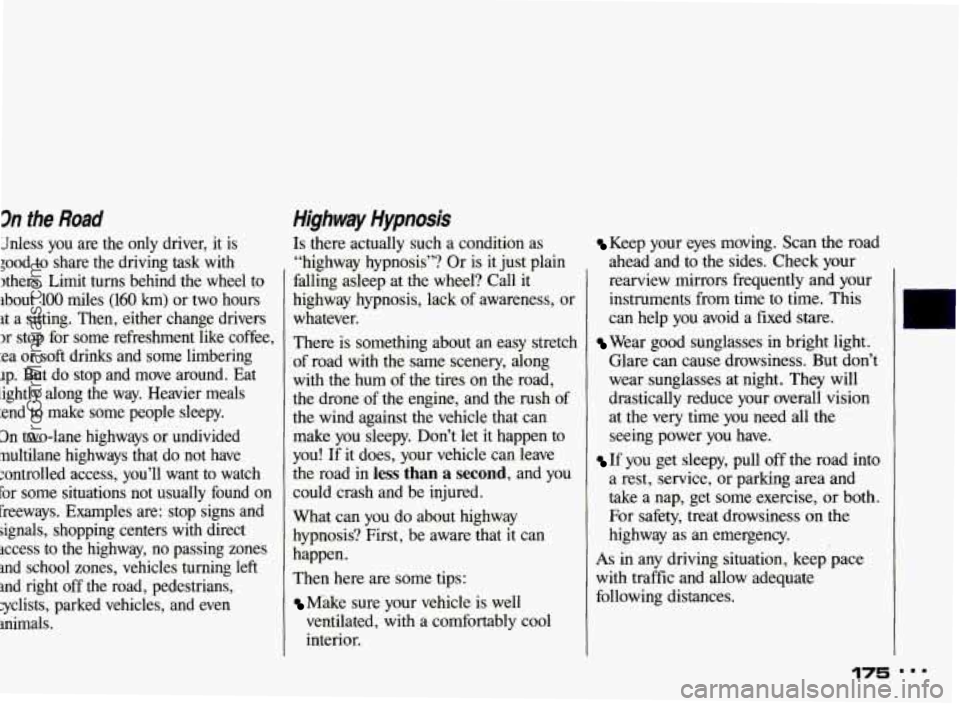
3n the Road
Mess you are the only driver, it is
;ood to share the driving task with
Ithers. Limit turns behind the wheel to
ibout 100 miles
(160 km) or two hours
it a sitting. Then, either change drivers
x stop for some refreshment like coffee,
:ea or
soft drinks and some limbering
lp. But do stop and move around. Eat
lightly along the way. Heavier meals
:end to make some people sleepy.
3n two-lane highways or undivided
multilane highways that do not have
;ontrolled access, you’ll want to watch for some situations not usually found on
freeways. Examples are: stop signs and
signals, shopping centers with direct
access to the highway, no passing zones
and school zones, vehicles turning left
and right off the road, pedestrians,
cyclists, parked vehicles, and even
animals.
Highway Hypnosis
Is there actually such a condition as
“highway hypnosis”? Or is it just plain
falling asleep at the wheel? Call it
highway hypnosis, lack
of awareness, o
whatever.
There is something about an easy stretch
of road with the same scenery, along
with the hum of the tires on the road,
the drone of the engine, and the rush of
the wind against the vehicle that can
make you sleepy. Don’t
let it happen to
you! If it does, your vehicle can leave
the road in
less than a second, and you
could crash and be injured.
What can you do about highway
hypnosis? First, be aware that it can
happen.
Then here are some tips:
Mike sure your vehicle is well
ventilated, with a comfortably cool interior.
Keep your eyes moving. Scan the road
ahead and to the sides. Check your
rearview mirrors frequently and your
instruments from time to time. This
can help you avoid a fixed stare.
Wear good sunglasses in bright light.
Glare can cause drowsiness. But don’t
wear sunglasses at night. They will
drastically reduce your overall vision
at the very time you need all the
seeing power
you have.
If you get sleepy, pull off the road into
a rest, service, or parking area and
take a nap, get some exercise, or both.
For safety, treat drowsiness on the
highway as an emergency.
As in any driving situation, keep pace
with traffic and allow adequate
following distances.
ProCarManuals.com
Page 196 of 322
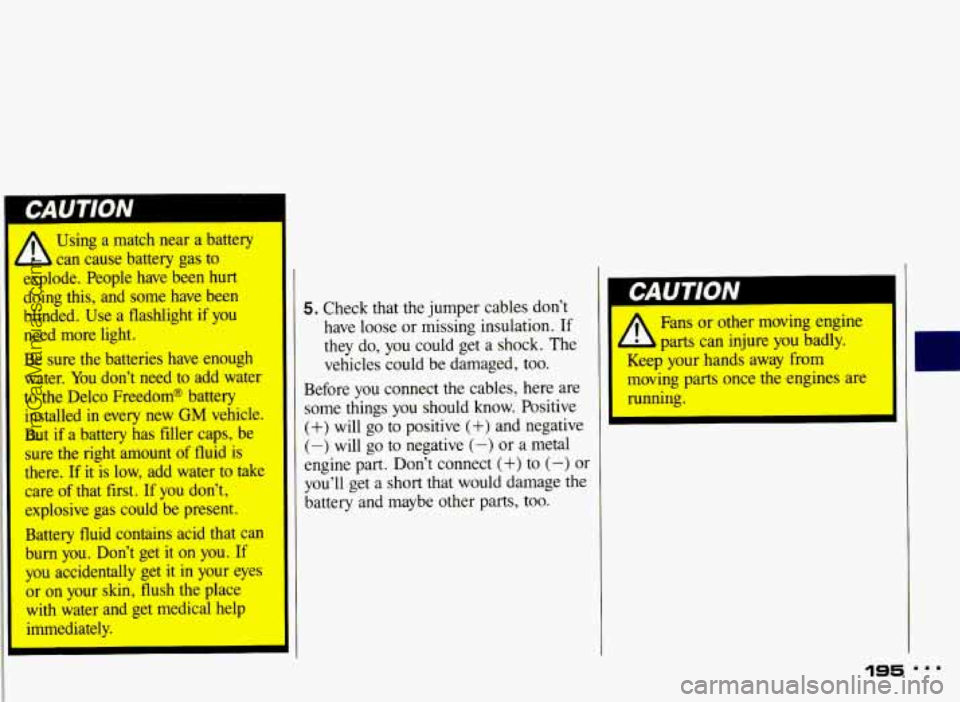
, Using a match near a battery
- b can cause battery gas to
explode. People have been hurt
doing this, and some have been
blinded. .Use a flashlight
if you
need more light.
Be sure the batteries have enough
water. You don’t need to add water
to the Delco Freedom@ battery installed in every new
GM vehicle.
But if a battery
has filler caps, be
sure the right amount
of fluid is
there. If
it is low, add water to take
care
of that first. If you don’t,
explosive gas could be present.
Battery fluid contains acid that can
burn you. Don’t get it
on you. If
you accidentally get it in your eyes
or on your skin, flush the place
with water and get medical help immediately.
5. Check that the jumper cables don’t
have loose or missin.g insulation.
If
they do, you could get a shock. The
vehicles could be damaged, too.
Before you connect the cables, here are
some things
you should know. Positive
(+) will go to positive (+) and negative
(-) will go to negative (-) or a metal
engine part. Don’t connect
(+) to (-) or
you’ll get a short that would damage the
battery and maybe other parts, too. Fans
or other moving engine
running.
ProCarManuals.com
Page 239 of 322

Service & Appearance Care
Automatic Transaxle Fluid (CONTJ
How to Add Fluid:
Refer to the Maintenance Schedule to
determine what kind
of transaxle fluid to
use. See the
Index under Fluids &
Lubricants.
If the fluid level is low, add only enough
of the proper fluid to bring
the level up
into the cross-hatched area on the
dipstick. It doesn't take much fluid,
generally less than a pint
(0.5 L). Don't
overfill. We recommend that you use
only fluid labeled DEXRON@-IIE,
because fluids with that label are made
especially for your automatic transaxle.
Damage caused by fluid other than
DEXRON@-IIE is not covered by your
new vehicle warranty. After adding
fluid, recheck the fluid
level as described under
How to Check.
When the correct fluid level is obtained,
push the dipstick back
in all the way.
Engine Coolant
The following explains your cooling
system and how to add coolant when
it
is low. If you have a problem with
engine overheating, see the Index under
Engine Overheating.
The proper coolant for your Pontiac
will:
Give freezing protection down to
Give boiling protection up to 262°F
Protect against rust and corrosion.
-34°F (-37°C).
(128" C).
Help keep the proper engine
temperature.
a
Let the warning lights work as they
should.
I.. 238
ProCarManuals.com
Page 241 of 322
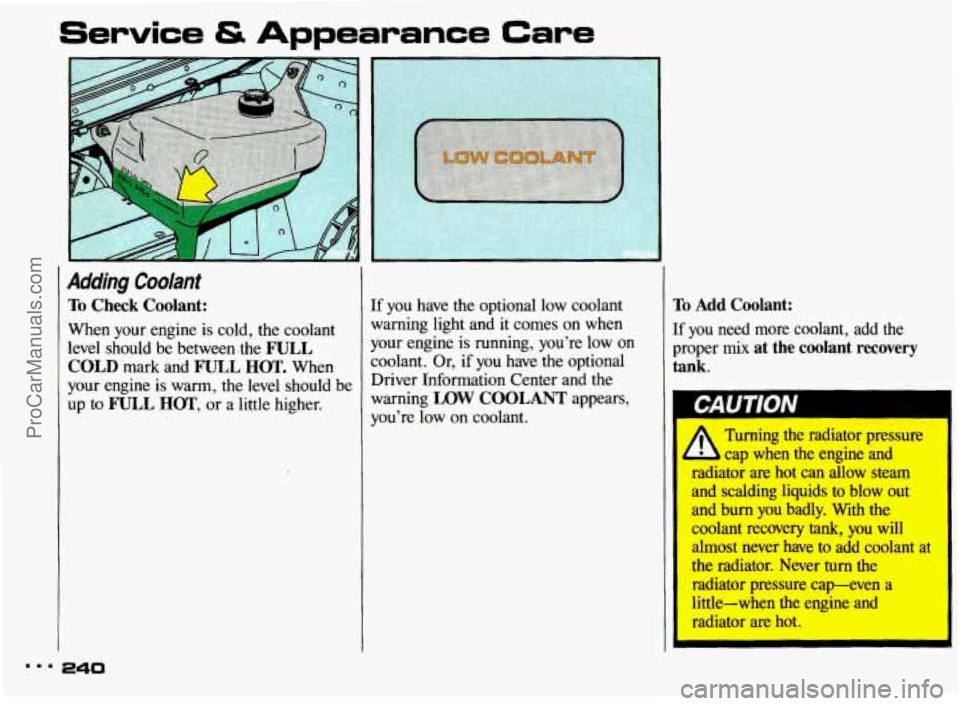
Service & Appearance Care
A’
Adding Coolant
To Check Coolant:
When your engine is cold, the coolant
level should be between the
FULL
COLD mark and FULL HOT. When
your engine is warm, the level should be
up
to FULL HOT, or a little higher.
m.. 240
If you have the optional low coolant
warning light and it comes on when
your engine is running, you’re low on
coolant. Or, if you have the optional
Driver Information Center and the
warning
LOW COOLANT appears,
you’re low on coolant.
To Add Coolant:
If you need more coolant, add the
proper
mix at the coolant recovery
tank.
II Turning the radiator pressure 1
- 1 cap when the engine and
raalator are hot can allow steam
and scalding liquids to blow out
and bum
you badly. With the
coolant recovery
tank, you will
almost never have to add coolant at
the radiator. Never
turn the
radiator pressure cap-even a
little-when the engine and
radiator are hot.
ProCarManuals.com